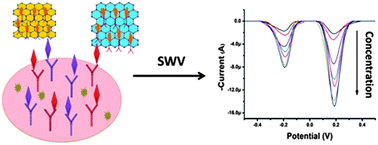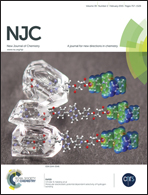Dual tumor markers assay based on surface charged graphene
Abstract
A new strategy for simultaneous detection of carcinoembryonic antigen and alpha-fetoprotein is introduced. In this work, an ionic liquid–reduced graphene oxide composite was combined with two different redox probes, thionine and ferricyanide, respectively, through electrostatic adsorption. The resulting nanocomposites were then attached to gold nanoparticles in order to supply a large, accessible surface for the immobilization of anti-carcinoembryonic antigen and anti-alpha-fetoprotein as immunosensing probes. A chitosan–AuNP modified glassy carbon electrode was used as a substrate to immobilize capture antibodies. As such, a sandwich-type electrochemical immunosensor for the simultaneous detection of carcinoembryonic antigen and alpha-fetoprotein was successfully developed. The electric potentials and voltammetric peaks measured using square wave voltammetry reflected the identity and concentrations of the corresponding antigen. Under optimized conditions, the immunosensor exhibited good sensitivity and selectivity with linear ranges of 0.05–100 ng mL−1, and detection limits for carcinoembryonic antigen and alpha-fetoprotein of 0.02 ng mL−1 and 0.01 ng mL−1 (S/N = 3), respectively. The reliability of the proposed immunosensor has been proven by the detection of carcinoembryonic antigen and alpha-fetoprotein in clinical serum samples and the results were in good agreement with a standard enzyme-linked immunosorbent assay.


 Please wait while we load your content...
Please wait while we load your content...